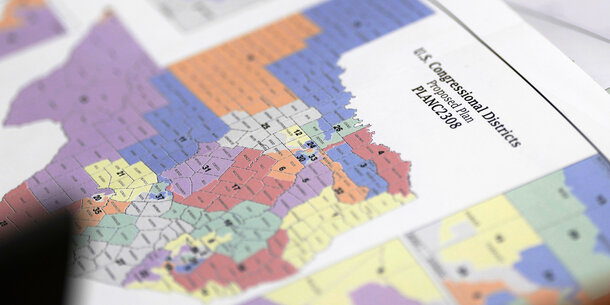On Monday, the Commerce Department and the Census Bureau released the first results of the 2020 Census, the constitutionally required, once-a-decade effort to count every person residing in the United States. Monday’s data release showed a total of seven congressional seats shifting among 13 states, with the gains made by states in the South and West.
These results arrive after years of planning to ensure a full, fair, and accurate count, as well as years of fights against threats to those plans, from underfunding to unprecedented political interference from the Trump administration. And states will soon receive the numbers they need to redraw political maps, along with many other data sets.
Why is the census important?
The census is about political power and money. Census results are used to allocate seats in the U.S. House of Representatives among the states. Similarly, states and localities use census data to redraw the boundaries of their congressional and other legislative districts. Census data also determines the distribution of over $1.5 trillion dollars annually in federal funds for much-needed programs like healthcare, food assistance, and education.
The stakes of this decade’s census are especially high for communities of color. The nation’s population growth over the past 10 years came entirely from nonwhite communities, and Latino, Black, and Asian American voters will collectively account for 80 percent of the increase in eligible voters between 2010 and 2020. For communities of color to receive political representation and critical investments commensurate with their size, they must be counted fully. The census, however, has historically failed to do so, struggling particularly to count Black, Latino, and Native American communities as accurately as it has white communities. These chronic undercounts have contributed to entrenched inequality.
What numbers were released Monday?
The Census Bureau released two sets of state population totals, as well as the number of seats each state will have in Congress for the next 10 years. The first data set shows the “resident population” of the 50 states, the District of Columbia, and Puerto Rico, as of Census Day, which was April 1, 2020. The second set — the apportionment counts — is the one the federal government uses to divide the 435 seats in the House among the states. The apportionment counts include all persons residing in the 50 states as of Census Day. In the 2020 Census, the apportionment population also includes U.S. Armed Forces personnel and federal civilian employees stationed outside the United States, as well as their dependents living with them. The bureau has allocated them to their home states.
Both these datasets are solely headcounts at the state and national levels. None of the data released Monday reveals any demographic information such as age, race, or ethnicity.
Monday’s announcement also included the number of congressional seats for each state, which will take effect for the 2022 elections. Six states gained seats — Colorado, Florida, Montana, North Carolina, Oregon, and Texas — while seven other states lost seats — California, Illinois, Michigan, New York, Ohio, Pennsylvania, and West Virginia.
The Commerce Department and the bureau arrived at these numbers by feeding the apportionment counts into a mathematical formula set by law. This formula ensures that every state gets one seat and, after that, states with more people get more seats than states with fewer people. While states now know how many congressional districts they must draw, they will need to wait longer for more granular population data before they can set new boundaries for this decade’s elections.
What happens next with the numbers?
The secretary of commerce has put the apportionment process into motion. Federal law sets the steps. Commerce Secretary Gina Raimondo delivered the population totals and congressional seat apportionments to President Biden on April 26. He must now transmit the population totals and seat apportionment to Congress, which will send the governors of each state certificates showing them how many seats their state will have going forward.
In the past, haven’t apportionment numbers come out earlier?
The numbers have come out faster before, but for the 2020 Census, accuracy is more important than speed. The Census Bureau has historically released apportionment numbers before December 31 the year the census is taken, in accordance with a federal statutory deadline. But last year, the Covid-19 pandemic hit the United States just as the 2020 Census was getting underway. The bureau consequently announced that it needed to extend many of its operations by several months, including knocking on doors of households that did not self-respond to the census and processing the data it collected. This second step, data processing, is crucial for helping safeguard the accuracy of census data and reducing the inequalities that have historically resulted when the census has undercounted communities like young children and people of color.
Advocates fought hard to ensure that the census would not be rushed. Despite the bureau’s conclusion that it needed more time to cope with the pandemic, the Trump administration last summer tried to speed up the entire census process so that the former president could try to carry out an unconstitutional directive to exclude undocumented persons from the apportionment count. A lawsuit, National Urban League v. Ross, resulted in a judicial order requiring the bureau to keep counting. Subsequently, the Trump administration abandoned its plans to rush data processing and manipulate the census data using citizenship data. The result of these fights has been an apportionment schedule close to the one the bureau had originally set for itself last year to respond to Covid-19.
Are these the only numbers we’ll see from the 2020 Census?
No, more data releases are yet to come. In the upcoming months and years, the bureau will produce additional data sets that will be central to social science research, business decision-making, and myriad other uses. Particularly significant among these pending releases, however, is the data set for redistricting, the process whereby states and local governments redraw the lines for their electoral districts for Congress, state legislatures, and other political bodies. This redistricting data set will include population counts and demographic information such as race and ethnicity down to the “census block” level, so it is much more detailed than the apportionment data. (The bureau does not release information that identifies specific individuals, in keeping with legal confidentiality protections to keep everyone’s data safe.)
As with the apportionment data, the Census Bureau announced that it needs more time to produce accurate redistricting files. It plans to transmit that data by September 30, 2021, and will release it in a less processed form by mid-August. Some states have challenged this extension of time in court. But, given the unprecedented conditions under which the Census Bureau had to enumerate the population in 2020, it needs time to produce data that will be fit for use.
What can states do to prepare for the release of census redistricting data?
A lot. The granular redistricting data needed to redraw maps will not be available until August or September, but despite the later than normal data release, there is much that states can begin to do now, like holding hearings to gather public input. States may also want to consider releasing preliminary maps for public comment using data from the American Community Survey, with the important caveat that this data will be much less precise than actual census data and shouldn’t be used to draw final maps.
Starting the work of public engagement while waiting for data will help states produce maps on time once the necessary data is published. Crowdsourcing information to identify communities of interest, which share common representational needs, also will inform map drawers of factors that may not be apparent in population data. Such input is indispensable for fair districts because it makes community needs a focal point for mapping decisions.
States may also want to consider whether filing deadlines or even primary dates for 2022 should be pushed back to give map drawers more time to run a robust redistricting process given that block-level data will come out later than normal this year.
What factors have shaped the 2020 Census count?
The 2020 Census has faced myriad challenges. The pandemic, hurricanes, and wildfires displaced people throughout the country and made canvassing door-to-door harder. Meanwhile, the Trump administration sought to add a citizenship question to the census form — which experts predicted would deter millions of people from completing it — and attempted to rush the count at the last minute to exclude undocumented people.
But other developments helped bolster the count. The Supreme Court blocked the citizenship question. Advocates prevented the Trump administration from skipping essential counting time, obtained an enforceable promise from the federal government that undocumented persons will be counted in the 2020 Census (as they always have been), and won crucial time for the bureau to process and spot errors in the data. And nonprofits and state and local governments worked tirelessly for years to encourage full participation in the census.
How accurate is the 2020 Census?
It’s too soon to say. The congressional seat allocations released on Monday tracked — but did not exactly match — projections from leading demographers and census experts, with slightly fewer seats changing hands among states than predicted. But that’s just one data point for analyzing the census’s overall quality, not the whole story by any means.
For starters, the quality of census data depends on how the numbers will be used. For example, the data might get each state’s relative share of the national population right — the only thing that matters for apportionment — but get the actual head counts in some, many, or even all states wrong. That could result in states and localities losing valuable federal funds down the line.
Or the apportionment totals could cover up racial or ethnic differential undercounts, which occurred in 2010. If severe differential undercounts happen this decade, that could damage the data’s usefulness for redistricting, in which accurate racial and ethnic data is necessary to keep communities of interest together and comply with the Voting Rights Act. And it may also leave undercounted communities short of federal funds.
Of course, some important clues about census quality already exist. In December, the bureau released national population estimates based on birth, death, migration, and other government records that provide the first rough benchmark for country-level counts. The national population number released on Monday — 331,449,281 — falls within the bureau’s estimates, about roughly between its low estimate (330,730,000) and its middle one (332,601,000). And experts have also been analyzing self-response patterns around the country, which might flag places where undercounts are more likely to have occurred.
But there are many other pieces to the puzzle that will only click into place over the next year. Most important will be the bureau’s Post-Enumeration Survey (PES), which, among other things, will help the bureau identify undercounts of any specific racial or ethnic group. The 2020 PES data will not be available in full until spring 2022. The bureau and the American Statistical Association will produce more quality metrics in the interim. And the redistricting data sets will arrive by September. Experts will analyze all these data sources together to get a fuller sense of how well the Census Bureau did this decade.





